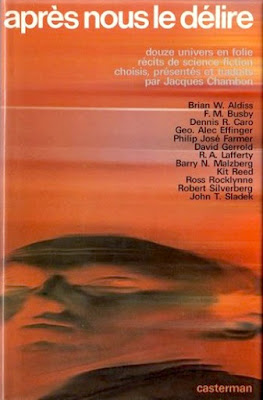"A Kingdom by the Sea" by Gardner Dozois
Dateline: An industrial American town, the present (early '70s, I guess)
Mason is a working-class schlub, a veteran whose father worked in a meat packing plant and who, after a period of drifting and his Army service, now works in the same plant, killing multitudes of cows in quick succession with a hammer, a human killing machine. Mason is 38 years old, and the job is starting to fatigue him. Exacerbating his trouble is the fact that a few months ago his live-in girlfriend of three years left him.
Dozois kills a lot of pages doing what I guess a lot of writers think they are supposed to do, describing in detail fogged up windows and rain and riding the bus to work at a crummy, dangerous and perhaps morally suspect job and then back home to an empty apartment to eat a frozen pizza and drink beer and watch an old movie on TV. Some of this is in past tense, some of it in present tense. I guess Dozois is performing some topical social commentary on industrialism and capitalism and all that; the story is preceded by the epigraph "For the Democratic National Convention," there are vague references to Vietnam, and there is a longish sequence in which Mason becomes enraged while watching an old movie because the characters are middle-class people who have no problems. (Unfortunately, Dozois doesn't name the movie; one wonders if he had a specific movie in mind.) Perhaps more interesting than these class- or economics-based angles are gender-based ones; "A Kingdom by the Sea" may be some kind of feminist story, its ending a metaphor for how (as feminists might say) men lure women in with promises of comfort and then destroy them.(Re: the title of the story, I didn't pick up on any other possible Poe references, though the phrase "hollow men" does appear. The story could be replete with references to poetry in English that sailed right over my uneducated noggin. There are plenty of direct religious references, and some references to "sci-fi" as well, with the suggestion that religion and SF are a poor guide to real life.)
The actual SF content of "A Kingdom by the Sea" consists of the fact that Mason has sex dreams about the presence of a woman; he doesn't see her or hear her speak but he senses her, senses a shared love and a mutual exchange of comfort and sexual ecstasy--Mason ejaculates in his pants while asleep in front of the TV. He comes to believe this woman, an angel or a spirit or something, is going to come to him, and that her arrival is imminent. The twist ending of the story is, I believe, that she does come to him, but the spirit Mason has been communing with is that of a cow and just as he does with all the others he kills it by bashing in its head with his hammer. (Maybe this is a pro-vegetarianism story.)
It doesn't feel right to call this story bad, because I suppose it is heartfelt and the product of some labor and all that, but it is not fun or enlightening or novel. It is just kind of there, inoffensive but unimpressive. Maybe it serves as a good example of the New Wave SF story which has lost almost all resemblance to traditional SF.
"A Kingdom by the Sea" would reappear in various Dozois collections and some foreign publications, and Ellen Datlow twice presented it to readers of her internet magazines.
 |
| Hubba hubba |
"Live, from Brechtsgaden" by George Alec Effinger
Dateline: Germany, the second decade of the 20th centuryOy, Effinger's story is perhaps even more New Wavey than was Dozois's, and a little harder to understand. I'm interpreting it as a meditation on guilt and forgiveness with its primary topic the crimes of Germany during the World Wars.
Much of the text of "Live, from Brechtsgaden" consists of what sounds like excerpts from travel guides, memoirs, and essays printed during the Cold War, all reflecting in some way on the Nazi regime, World War II, and the Holocaust. The rest of the text suggests that those paragraphs are being spoken, mostly in English, by a young German woman who lies in a coma; it seems she fell into the coma before World War I and was taken to a sanitarium, and then when the war broke out was moved home because her caretakers had to join the war effort. Later we are given the idea that this comatose woman is inhabited by the lost soul of a Jewish-American tourist from the post-World War II period; this second young woman has the same first name as the comatose woman and has taken a particular interest in the Holocaust, having been charged by a relative to remember the sufferings of her people. Eventually the comatose woman simply vanishes, forgotten, and the lost soul has to drift on and start anew; I guess these fantastic events symbolize the way even the atrocities of the Hitler government will be forgotten, whether or not they are forgiven, and how Germany and the world will inevitably move on.
As with Dozois's story, one is reluctant to admit not liking "Live, from Brechtsgaden" because it is about a serious topic and presumably represents a cri de coeur and shows literary ambition (and if you say you don't like it maybe people will call you stupid or say you are insufficiently outraged by racism) but I'd be lying if I said I enjoyed it or was moved by it or whatever.
Damon Knight and Robert Silverberg apparently enjoyed this story more than I did, or maybe thought it the serving of broccoli SF readers ought to add to their diet of sword-swinging barbarians, ray pistol-toting spacemen and lectures about radiation and gravity. Just two years after its debut in Orbit 10, Silverberg included it in Alpha 5, and a year after that it showed up again in The Best from Orbit, Volumes 1-10. You can also find it in the Effinger collection Dirty Tricks.
"Dorg" by R. A. Lafferty
Dateline: Oklahoma in the overpopulated futureThis is a fun little story that gently satirizes the dominance of postwar culture by youth and the hypocrisy and fraudulence of politicians and other elites, as well as vagaries of popular taste; the backbone of the tale is a farcical look at the question of to what extent art imitates life and vice versa.
Starvation threatens the world! A new comic strip character has caught the imagination of the public--called the dorg, this creature matches the populace's hopes, fears and mood, as it can derive sustenance from eating rocks and is perennially worried. A renegade psychologist publishes his theory that animals do not develop naturally over millions of years of evolution, but instead appear when needed by mankind, and that they are either summoned, or prophesized, by artistic representations--ignoring all evidence to the contrary, this head shrinker claims that there were no horses or deer or whatever until after cave men painted them on cave walls! He asserts that a real dorg is due to appear at any moment. And, true enough, people in Oklahoma start sighting the fictional beast!
Government officials, in their slapdash ramshackle way, have been trying to resolve the food crisis, and the y scramble to take advantage of the dorg. A commission is convened, and among its members are the cartoonist and the psychologist. The commission heads to OK, led, de facto if not de jure, by a representative of a sort of government-sponsored pressure group modelled after a guild or trade union, Amalgamated Youth--all entities must, by law, include an Amalgamated Youth representative in their ranks. Illustrating how bogus such political activist groups are, the AY rep, who got this job because she is good-looking, is actually older than everybody else on the commission, but don't you think this stops her from calling her colleagues a bunch of old men and haranguing them about the need for fresh new ideas; she also is not above using violence to encourage her colleagues.
As the story ends we know that the dorgs are real, but cannot be sure how responsible the cartoonist is for their appearance or whether their appearance is going to free the world from hunger.
A charming, fun little thing, like a sweet dessert after the pretentious downers we have been ingesting. I might add that if we suspect Dozois's story of promoting left-wing economic, class, gender, and interspecies politics, it might make sense to suspect Lafferty's story of just the opposite, or at least of mocking progressive politics, with its, however goofy, dismissal of the theory of evolution and vindication of the primacy of man over beast, as well as its portrayal of a woman political activist who is corrupt, violent, presumptuous and ineffectual.
"Dorg" reappeared in 1977 in a French anthology, and later in various English and translated Lafferty collections.
More postwar SF stories from the MPorcius Library's anthology shelves in the next episode of MPorcius Fiction Log.















































